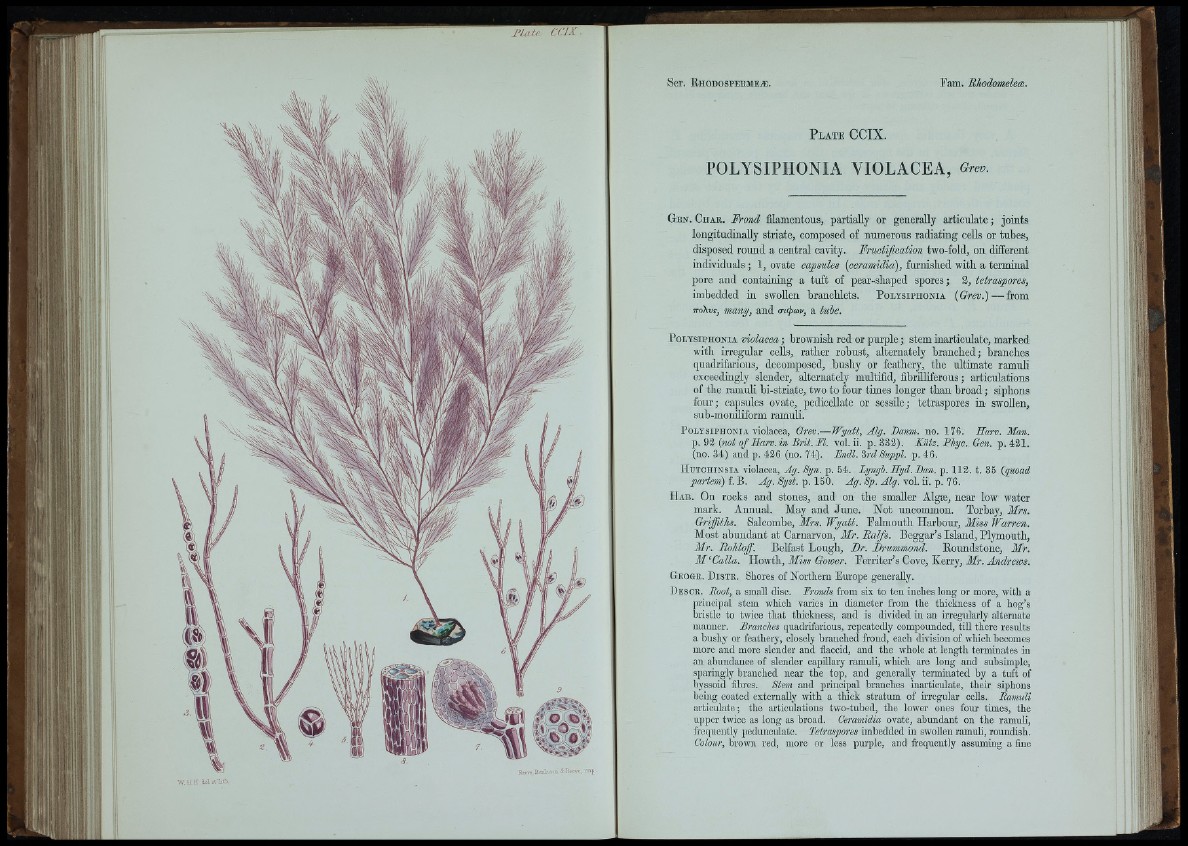
Eecvï.B.’a h a n i &Ruovc,imy
W. a.H del ètüfh
P late C C IX .
POLYSIPHONIA VIOLACEA, Grev.
G e n . C h a k . Frond filamentous, partially or generally a rtic u la te ; joints
longitudinally striate, composed of numerous radiating ceEs or tubes,
disposed round a central cavity. Fructification two-fold, on different
in dividuals; 1, ovate capsules [ceramidia), furnished with a terminal
pore and containing a tu ft of pear-shaped spores; 3, tetraspores,
imbedded in swollen branchlets. P o l y s ip h o n ia (G re v .)— from
voXvs, many, and a-itbrnv, a tube.
P o l y s ip h o n ia violacea ; brownish red or purple ; stem inarticulate, marked
with irregular cells, rather robust, alternately branched; branches
quadrifarious, decomposed, bushy or feathery, th e ultimate ramuli
exceedingly slender, alternately multifld, fibriUiferous ; articulations
of the ramuli bi-striate, two to four times longer th an broad ; siphons
fo u r; capsules ovate, pedicellate or sessile; tetraspores in swollen,
sub-moniliform ramuli.
P o l y s ip h o n ia violacea, Grev.— Wyatt, Alg. Banm. no. 176. Harv. Man.
p. 92 (not o f Ilarv. in Brit. M. vol. ii. p. 333). Kiitz. Fhyc. Gen. p. 421.
(no. 34) and p. 436 (no. 74). Endl. 3rd Swppl. p. 46.
H utch in s ia violacea, Ag. Syn. p. 54. Lyngb. Hyd. Ban. p. 113. t. 35 (quoad
partem) i.H. Ag. Syst.-p. 169. Ag. Sp. Alg. Yol.ii.-p. 19.
H a b . On rocks and stones, and on th e smaller Alg®, near low water
mark. Annual. May and Ju n e . N o t uncommon. Torbay, Mrs.
Griffitlis. Salcombe, Mrs. Wyatt. F almouth Harbour, Miss ÍFarren.
Most abundant at Carnarvon, M r. R alfs. Beggar’s Island, Plymouth,
M r. Rohloff. Belfast L ough, B r . Brummond. Eoundstone, Mr.
M 'C a lla . HoYiÜí, Miss Gower. Ferriter’s Cove, Kerry, Afr.
G e o g r . D is t r . Shores of Northern Europe generally.
D e s c r . Root, a small disc. Eronds from six to ten inches long or more, with a
principal stem which varies in diameter from the thickness of a hog’s
bristle to twice that thickness, and is divided in an irregularly alternate
manner. Branches quadrifarious, repeatedly compounded, tiU there results
a bushy or feathery, closely branched frond, each division of which becomes
more and more slender and flaccid, and the whole at leng-th terminates in
an abundance of slender capillary ramuli, which are long and subsimple,
sparingly branched near the top, and generally terminated by a tuft of
byssoid fibres. Stem and principal branches inarticulate, their siphons
being coated externally -BÚth a thick stratum of irregular cells. Ramuli
articulate; the ai-ticulations two-tubed, the lower ones four times, the
upper twice as long as broad. Ceramidia ovate, abundant ou the ramuli,
fi-cquoutly pedunculate. Tetraspores imbedded in swoUeu ramuli, roundish.
Colour, brown red, more or less pm-ple, and fi-equently assuming a fine